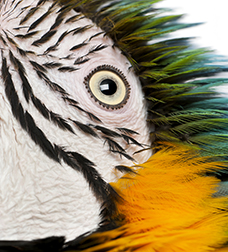You all have noticed that the toys in our store and the bird section of any pet supply store are more colourful than other pet toys. This is because birds and especially Parrots are attracted to colour. Colour is so important to Parrots that, like us, they have their favourites. Some Parrots will even avoid anything in a colour they don’t like including toys, food, or your new shirt.
Both humans and birds have photoreceptor cones in the retina that allows them to see colours. Birds have 12 times the number of cones than humans. Humans have three types of cones that allow us to see red, green or blue. This is called trichromatic colour vision. Birds have a fourth type of cone, or tetrachromatic colour vision, which expands their visible light spectrum to include ultraviolet frequencies.
The ability to see ultraviolet light helps birds to communicate species, gender and perhaps even social standing. Parrots can only see ultraviolet light under normal daylight conditions or with full-spectrum lights that include ultraviolet A frequency, whereas humans require the assistance of black light.
As with humans, ultraviolet light (UVB) is important to birds’ health as it acts on Vitamin D precursors to produce Vitamin D. Vitamin D precursors are produced by a Parrot’s Uropygial gland, or preen gland. The oil produced by this gland is spread over the feathers by the Parrot during preening, hence the name. The Vitamin D in this preen oil is absorbed through the skin keeping the skin, feathers, and bill supple while providing a protective layer against harmful bacteria. This is the reason full-spectrum lighting benefits Parrots that pluck their feathers.
In contrast to humans, birds’ retinas do not contain blood vessels. This prevents light scattering and provides the birds with more visual acuity. This is essential for survival in the wild but will often cause our pet birds to take flight before we notice and prevent what alarms them.
The mass of the average bird’s eyes accounts for 15 per cent of their head as compared to the human eyes that account for 2 percent of the head. Birds also have 13 to 25 cervical (neck) vertebrae providing them with a highly flexible neck. These things combined give a bird effective 360 degree vision.
Next to a bird’s ability to fly, their acute eyesight is their primary defence against predators and provides them with a significant advantage while foraging for food. Their sight is also a primary means of communication among the flock, which is especially true of Parrots.
Although their calls can be heard for miles in the wild, when settled in their roosting place with their mate, offspring or siblings they continue to communicate through body language. The head will go down when they want to be preened, a wing goes up when they want to get cozy or a foot stretched out to show others to stand clear. A Parrot will even pin or flash their eyes to ward off a mate or their human caregiver. Our ability to see these sometimes subtle movements helps us communicate better with them. It allows us to respect their space when asked or move in when they beckon us, building the trust that is essential when keeping Parrots as companion pets.
Our blog promotion this week is 25% off colourful wood toys. Simply use coupon BLOG3732 or print our COUPON and bring it along to the store.

